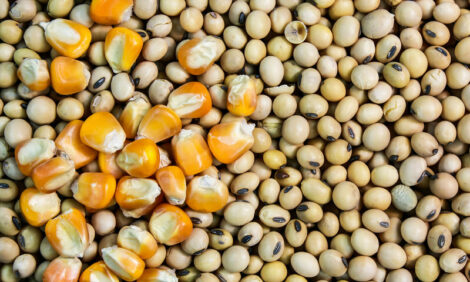



Imported feed ingredients: supplier’s sourcing, biosecurity and shipping are vital to product integrity and safety
What are the possible risks of importing ASF through feed ingredients – including medicated feed additives used for managing swine disease?Brian Payne, DVM, technical services veterinarian at Zoetis, recently talked with editors of Pig Health Today about African swine fever (ASF) and the possible risks of importing the virus through feed ingredients – including medicated feed additives used for managing swine disease.
Research has shown that ASF virus can survive for weeks or months in certain livestock-feed ingredients, even after trans-oceanic crossings.1 With so many vitamins and other feed ingredients imported from China, do ASF outbreaks in that country pose a risk to US pork production?
Never say never, but the American Feed Industry Association, National Pork Board, Swine Health Information Center and American Association of Swine Veterinarians are working – together and with government officials – to minimise that risk. It’s important to note that while three variants of coronavirus (PEDV, PEDV InDel and PDCoV) and Senecavirus A have entered the US since 2013,2 we can’t say with certainty that imported feedstuffs acted as fomites for these pathogens.3

So, where do the risks for virus contamination lie?
It’s not only about where a feed ingredient is manufactured or blended. The level of risk varies with the way feed ingredients are sourced, handled, manufactured and transported. It also hinges on the flow of the products and what protections are in place throughout the manufacturing and distribution chain. In the end, it’s more about the integrity and reputation of the manufacturer and the ability to create and maintain biosecure production and supply channels.
What imported feedstuffs have the most potential for transmitting ASF?
Research with Senecavirus A, which has been shown to be more stable than the ASF virus, indicates a higher rate of survival in raw soybean meal, choline, alternative pet-food ingredients and any products with porcine-based ingredients.4
Zoetis feed medications from China
Zoetis is a leading supplier of medicated feed additives for the US pork industry. Are any of Zoetis’ swine feed medications made in China?
Yes, Zoetis has several Type A medicated feed articles for swine with origins in China: Aureomycin® 90 and Aureomycin®100 Granular, Aureomycin® 90 Meal, Aureomycin®50 Granular and Aureomix® S 40/40 Granular, ChlorMax® 50, Lincomix® 20 and Lincomix® 50.
Our Lincomix products, which contain lincomycin, are made entirely at our modern plant in Suzhou, China, and then exported to the US and other markets.
The API, or active pharmaceutical ingredients, for sulfamethazine (SMZ) and some chlortetracycline (CTC) products used in the US are also produced in China and obtained from sources that meet Zoetis’ rigid manufacturing and biosecurity standards.
Are any of their inert or excipient ingredients in Zoetis feed medications from China potential carriers of the ASF virus?
The excipients used in the CTC products (both the single and combination Type A medicated articles) include mineral oil, rice hulls, calcium sulfate and/or calcium carbonate. All of these ingredients are US-sourced and are considered minor risks for virus transmission.
Our Lincomix products are made with soybean hulls sourced in China. Soybean hulls are considered moderate risks for virus transmission, but we have many processes in place to safeguard our products from contamination.
Soybean hulls versus meal
If the soybeans hulls used in Lincomix are sourced from China - presumably from agricultural areas where the ASF virus is present - isn’t that a red flag for users of the product?
Not at all. All soybean hulls used in Lincomix are acquired from a Zoetis-dedicated source that processes the hulls at a closed Zoetis-dedicated facility. The hulls are purposefully heat treated to kill viruses before they are shipped to the Zoetis-owned Lincomix plant in China.
What’s more, all sourced ingredients, including heat-treated soybean hulls, are transported by trucks and drivers dedicated to Zoetis shipments. They’re not contractors who do loads for other manufacturers. As a result, there is little risk of virus contamination.
Even with dedicated trucks and drivers, aren’t there opportunities for the soybean hulls or other ingredients to pick up the ASF virus on the way to the plant?
The chances are slim. We maintain a strict, closed, unidirectional flow of all materials, equipment and people. That means once the ingredients are in our system, they flow in only one direction with elevated biosecurity along the way. The people and the equipment handling them also maintain a unidirectional flow, which greatly reduces the chance of contamination from people or equipment.
Are the treated soybean hulls quarantined before they enter the Lincomix plant?
No, they are shipped directly to the Zoetis plant and used immediately in the manufacture of Lincomix. We actually feel that is a benefit – that they are treated and used almost immediately, rather than sitting in a holding area and opening the door to possible contamination.
Recommended hold times
Zoetis recently announced that any feed medications with origins in China would not be shipped to US feed mills for a minimum of 78 days after the “born-on” date of the product or ingredient. What constitutes a “born-on date”? And why 78 days?
The born-on date is when the API or finished product is either bagged or sealed in a container to help prevent the risk of contamination.
As for product hold times, the National Pork Board and other industry associations have recommended 286 days for feed ingredients considered high risk – those containing soybean meal, as well as those made with porcine-based ingredients.5
For all other feed products, current research shows that a 78-day holding period allows enough time to degrade 99.99 percent of viruses, if any. Bear in mind this research was conducted with Senecavirus A, which is even more stable than the ASF virus.6
Just to be clear: You said a 286-day hold time is recommended for products containing raw soybean meal. If Lincomix products are manufactured with soybean hulls sourced in China, is a 78-day hold time adequate?
We believe that it is, for several reasons. First, the 286-day hold time does not apply to products made with soybean hulls. Furthermore, the soybean hulls used in Lincomix products are heat treated to deactivate any viruses. Producers in the US and other markets can therefore use Lincomix products and our other feed medications with confidence.
For added peace of mind, wouldn’t it make more sense to test the product for ASF virus before it leaves the plant in China?
That’s not possible. Currently, there is no test specifically allowed during manufacturing to determine if there’s ASF contamination. Only government laboratories are authorised to test for ASF and other foreign animal-disease viruses.
Furthermore, feed medications are bulk materials, so sampling would represent only a small portion of the total product. That increases the risk of getting false negatives and may give manufacturers a false sense of security.
Secure shipping
What precautions is Zoetis taking with feed-medication packaging?
Suppliers and transporters of single-use totes and bags used for packaging API or blended products are also dedicated to Zoetis - again to maintain a closed, unidirectional flow of materials. They’re not delivering packaging materials to companies other than Zoetis. All bagged products are wrapped in polyethylene for added protection and security.
Once a Type A medicated article or API manufactured in China is in a bag or plastic tote, stamped with a born-on date and ready for shipment, how does Zoetis maintain biosecurity between the plants in China and its manufacturing or distribution sites in the US?
That’s the easy part. After products are packaged, they are placed into clean, steel shipping containers, which are then sealed at the plant and shipped by truck to the seaport, where they are loaded onto ships bound for the US. Unless they are opened by a US Customs agent in Seattle or other US port, the containers remain sealed and are shipped by train to Zoetis manufacturing or distribution facilities in Iowa (Des Moines and Eagle Grove). All US-blended CTC products are trucked from Zoetis’ US manufacturing plants to either its warehouse near Kansas City or directly to customers.
So typically, how long does it take for the API or finished products made in China to reach the US manufacturing or distribution points?
Usually, from the plant in China to the Zoetis plants or warehouse in the US, we’re looking at an average transit duration of 80 days or more (which is in accordance with Zoetis’ internal standards). As a result, most Zoetis API or finished product has already cleared the industry-recommended, 78-day hold time by the time it’s at one of our US facilities. Either way, no product with origins in China is shipped to customers until 78 days after the born-on date.
Zoetis manufacturing sites
Tell us more about Zoetis’ feed-medication plant in Suzhou, China.
The plant is located about one hour northwest of Shanghai. It’s a modern facility – built in 2015, inspected and approved by the Food and Drug Administration (FDA) in 2016 and officially put into production in 2017. It is used only for manufacturing Zoetis feed medications for livestock and poultry. No other products are made there. Products are exported to Europe and the Asia Pacific region, as well as to the US and Canada.
To what extent are feed medications or API made in China regulated by the US Food and Drug Administration (FDA)?
Pharmaceutical plants outside of the US that export products to the US are required to comply with the same FDA standards for manufacturing, testing, product handling, safety and packaging that apply to plants in the US.
In addition, FDA’s Foreign Verification Program requires importers such as Zoetis to perform certain risk-based activities to verify that food imported into the US – in this case, feed ingredients – has been produced in a manner that meets applicable US safety standards.
The steps Zoetis takes to prevent product contamination are impressive. However, some US customers might ask why these ingredients are produced in China in the first place. One of Zoetis’ top-selling feed medications, BMD® (bacitracin methylene disalicylate), is made in Chicago Heights, Illinois. Why not move manufacturing to a US location for added biosecurity?
That’s easier said than done. Not only from a manufacturing or capacity standpoint, but there are also regulatory considerations. To comply with FDA requirements, we can’t just pick up the CTC or feed-grade lincomycin API, for example, and move it to the US and start blending it with materials produced in the US. All of that – the blending, the mixing, the manufacturing process – would have to go through US government approval, a process that could take years.
It’s also important to remember that products like Lincomix are used worldwide – not just in the US. In fact, products made at Suzhou alone – medicated feed additives plus premixes and soluble powders – are shipped to more than 60 countries in Asia Pacific, Europe and North America. We consider Suzhou to be an ideal location for servicing both the US and other swine markets. For the same reason, it makes sense to source API for our CTC and SMZ products in China.
In summary, we’re proud of our modern manufacturing plant in Suzhou. More important, we are confident in the many biosecurity safeguards and processes we have in place to deliver high-quality, dependable products for the US pork industry.
| References | ||||
|---|---|---|---|---|
| 1. Dee SA, Bauermann FV, Niederwerder MC, Singrey A, Clement T, de Lima M, et al. | ||||
| (2018) | Survival of viral pathogens in animal feed ingredients under transboundary shipping models | |||
| 2. USDA-Animal and Plant Health Inspection Services | ||||
| Swine Enteric Coronavirus Introduction to the United States: Investigative Report. pp. 1-2. | ||||
| 3. USDA-Animal and Plant Health Inspection Services | ||||
| Swine Enteric Coronavirus Introduction to the United States: Investigative Report. p. 43.4. | ||||
| 4. Dee SA, Bauermann FV, Niederwerder MC, Singrey A, Clement T, de Lima M, et al | ||||
| (2018) | Survival of viral pathogens in animal feed ingredients under transboundary shipping models | |||
| 6. Dee SA, Bauermann FV, Niederwerder MC, Singrey A, Clement T, de Lima M, et al | ||||
| (2018) | Survival of viral pathogens in animal feed ingredients under transboundary shipping models |






